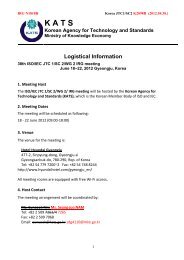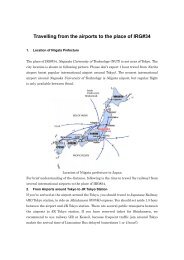ISO/IEC JTC1/SC2/WG2/IRG N 1822
ISO/IEC JTC1/SC2/WG2/IRG N 1822
ISO/IEC JTC1/SC2/WG2/IRG N 1822
You also want an ePaper? Increase the reach of your titles
YUMPU automatically turns print PDFs into web optimized ePapers that Google loves.
Doc. Type: Input to <strong>ISO</strong>/<strong>IEC</strong> 10646<br />
<strong>ISO</strong>/<strong>IEC</strong> <strong>JTC1</strong>/<strong>SC2</strong>/<strong>WG2</strong>/<strong>IRG</strong> N <strong>1822</strong><br />
<strong>ISO</strong>/<strong>IEC</strong> <strong>JTC1</strong>/<strong>SC2</strong>/<strong>WG2</strong><br />
Coded Character Set<br />
Secretariat: Japan (JISC)<br />
Date: 2012-05-09<br />
Title: <strong>ISO</strong>/<strong>IEC</strong> 10646: Requirements for CJK Font Provision<br />
Source: <strong>ISO</strong>/<strong>IEC</strong> 10646 Project Editor<br />
Project: <strong>JTC1</strong> 02.10646<br />
Status: For review by <strong>IRG</strong><br />
Date: 2012-05-09<br />
Distribution: <strong>IRG</strong><br />
Reference:<br />
Medium:<br />
Summary: This document covers two topics: 1) requirements for CJK fonts covering new repertoires, 2)<br />
status of CJK fonts covering existing repertoires. It also gives guidelines to streamline coverage for<br />
existing characters.<br />
Background: As a consequence of the review of the multi-column version of CJK Extension B, the<br />
mechanisms for displaying all characters for all sources have become much more complex. Not only can<br />
any characters can be expressed from any of the 9 sources (G, T, H, M, J, K, KP, V, and U), but also any<br />
content from those sources can be expressed using a very large number of fonts. Because of that<br />
complexity it has become more important to allow versioning for font resources, allowing side by side<br />
install. At the same time it is desirable to decrease the complexity by streamlining the font descriptions in<br />
the chart production tool. This can be mainly achieved by creating full updates for the various sources.<br />
Versioning: Versioning is the process by which a unique name is given to a font file and its logical<br />
names. Note that the important part is the uniqueness of its logical names. Typically fonts may have<br />
multiple logical names: Family, style, PostScript (PS) that may be different. The uniqueness can be<br />
provided by appending a variable to a fixed part, the variable being a number, the date, etc… Examples<br />
from the K Source and T source lists:<br />
Hg_CJK_EUC_KR_v50<br />
CJK_B_Delta_TCA20111101<br />
where ‘v50’ is a version number, and 20111101 represents a date. This allows a future version which<br />
could be called ‘Hg_CJK_EUC_KR_v51’ to be installed side by side with the previous version allowing<br />
characters to be used from both fonts at the same time if needed (and font with a new date for the second<br />
example).<br />
1
Font encoding: In preliminary phases of the development of a CJK Extension it is somewhat difficult to<br />
affect a stable code point to a given glyph because the code point allocations from the various CJK<br />
sources are interrelated. The production tool has a definition file allowing remapping either individually<br />
or by range. Examples:<br />
CMEX_ATSong,21 /Q=2A719 /R=4E23-4E23<br />
CMEX_ATSong,21 /Q=2A71E /R=4E29-4E2B<br />
The first example remaps the character 4E23 (font internal coding) to 2A719 (chart code point). The<br />
second example remaps the characters 4E29-4E2B to 2A71E-2A720.<br />
This mechanism can be used for large repertoire (it was used extensively during the development of CJK<br />
Extension C). However it can become cumbersome to maintain and can introduce errors. Furthermore<br />
regression may occur when final fonts are produced and the mappings are removed.<br />
Therefore it is recommended that usage of mapping should be minimized and font encoded to the current<br />
proposed code points as soon as possible.<br />
Furthermore, should mapping be required, a machine readable document describing this mapping must be<br />
provided to the project editor.<br />
Font streamlining: During the production of the 3 rd edition of 10646, to avoid regression risks, it was<br />
decided to not replace large fonts when updates were required, but instead to use overlapping fonts<br />
replacing only the updated or added characters. Example for the K source:<br />
$KSOURCE<br />
CJK_BMP_KR-v46,21,1 /X=0000-10FFFF /I=3400-9FFF; URO and A<br />
CJK_BMP_KR-v46,21,1 /X=0000-10FFFF /I=F900-FA0B; Compat BMP<br />
CJK_BMP_KR-v46,21,1 /Q=FA2E /R=90DE-90DE; Compat BMP<br />
CJK_BMP_KR-v46,21,1 /Q=FA2F /R=96B7-96B7; Compat BMP<br />
Hg_CJK_EUC_KR_v50,21,1 /Q=2700E /R=2700E-2700E; 3 fixes for FDIS 10646 3rd ed<br />
Hg_CJK_EUC_KR_v50,21,1 /Q=203DD /R=203DD-203DD<br />
Hg_CJK_EUC_KR_v50,21,1 /Q=25566 /R=25566-25566<br />
CJK_ExtB_KR-v45,21,1 /X=0000-10FFFF /I=20000-2A6DF; B<br />
CJK_ExtC_KR-v45,21,1 /X=0000-10FFFF /I=2A700-2B73F ;C<br />
Two CJK Compatibility characters were added in FA2E and FA2F, three CJK Extension B characters<br />
were updated.<br />
Based on a resolution adopted in <strong>IRG</strong> meeting #37, it was agreed to use the updated font<br />
(Hg_CJK_EUC_KR_v50) for all K sources for future editions of the standard. This results in a much<br />
simpler definition as follows:<br />
$KSOURCE<br />
Hg_CJK_EUC_KR_v50,21,1 /X=0000-10FFFF /I=3400-9FFF; URO and A<br />
Hg_CJK_EUC_KR_v50,21,1 /X=0000-10FFFF /I=F900-FA2F; Compat BMP<br />
Hg_CJK_EUC_KR_v50,21,1 /X=0000-10FFFF /I=20000-2A6DF; B<br />
Hg_CJK_EUC_KR_v50,21,1 /X=0000-10FFFF /I=2A700-2B73F ;C<br />
This definition is now in use for draft charts being processed after the issuance of 10646:2012 (3 rd<br />
edition). Similar streamlining was done for the H source (Hong Kong SAR) where a consolidated font<br />
was available and the regression risk was minimal. The last update concerns the BMP CJK Compatibility<br />
Ideographs for the J (Japan) source where existing glyphs from the official J source are now used.<br />
2
Today, many sources have complicated descriptions. As much as possible they should be simplified in a<br />
way similar to what was possible for the K source. The following sections describe all CJK sources with<br />
suggestion for concerned parties on how to create consolidated versions of their fonts if they desire to do<br />
so.<br />
G source (China PRC)<br />
Current definition:<br />
$GSOURCE<br />
ZDSUpdate11,21,1 /Q=3D34 /R=3D34-3D34<br />
ZDSUpdate11,21,1 /Q=3EAC /R=3EAC-3EAC<br />
ZDSUpdate11,21,1 /Q=4227 /R=4227-4227<br />
ZDSUpdate11,21,1 /Q=4565 /R=4565-4565<br />
ZDSUpdate11,21,1 /Q=4907 /R=4907-4907<br />
ZDSUpdate11,21,1 /Q=49C8 /R=49C8-49C8<br />
ZDSUpdate11,21,1 /Q=4C41 /R=4C41-4C41<br />
ZDSUpdate11,21,1 /Q=5829 /R=5829-5829<br />
ZDSUpdate11,21,1 /Q=5AB2 /R=5AB2-5AB2<br />
;ZDSUpdate11,21,1 /Q=5FF9 /R=5FF9-5FF9 ; unwanted, see 225D6<br />
ZDSUpdate11,21,1 /Q=6A37 /R=6A37-6A37<br />
ZDS,21,1 /X=0000-10FFFF /I=3400-9FFF; URO and A<br />
FZSongYi_EXB-Z13_<strong>IRG</strong>35, 21 /X=0000-10FFFF /I=20000-2A6DF; B Overlay for FDIS 10646 3rd (41 chars)<br />
China_ExtB_Modified,21 /Q=20768 /R=20768-20768 ; <strong>IRG</strong>37 Review<br />
China_ExtB_Modified,21 /Q=22903 /R=22903-22903 ; <strong>IRG</strong>37 Review<br />
China_ExtB_Modified,21 /Q=2292A /R=2292A-2292A ; <strong>IRG</strong>37 Review<br />
China_ExtB_Modified,21 /Q=240D5 /R=240D5-240D5 ; <strong>IRG</strong>37 Review<br />
China_ExtB_Modified,21 /Q=26E82 /R=26E82-26E82 ; <strong>IRG</strong>37 Review<br />
FZSongYi_EXB-Z13,21 /X=0000-10FFFF /I=20000-2A6DF; B<br />
China_ExtC, 21 /X=0000-10FFFF /I=2A700-2B73F ;C<br />
ChinaUNC,21 /X=0000-10FFFF /I=2B740-2B81F ;D<br />
Explanation :<br />
The ZDS font (file name CJK+A2009-12-21.ttf created 12/21/2009) covers the URO and Extension A. It<br />
is overlapped by the ZDSUpdate11 font (file name 11_G_Hanzi_2010-08-4.ttf created 8/4/2010) for 11<br />
characters. Of these 11 characters, only 10 were applied. After further study, the change for 5FF9 was not<br />
done to avoid a duplicate with 225D6. This had some consequences for the T source for 5FF9.<br />
For reference: 5FF9 忹, 225D6 𢗖 (issue concerns the middle stroke of the second component).<br />
Ideally the ZDS font should be updated with the remaining 10 characters from the ZDSUpdate11 font.<br />
The FZSongYi_EXB-Z13 font (File name FZSY_SIP.ttf created 12/12/2005) covers Extension B. It is<br />
overlapped by the FZSongYi_EXB-Z13_<strong>IRG</strong>35 font (file name CJK_B_Modified_G_Fonts20110704.ttf)<br />
for 41 characters. It is further overlapped by the China_ExtB_Modified font (file name<br />
ChinaExtBModifidOn<strong>IRG</strong>37-20111108.ttf created 2011/11/08) for 5 characters.<br />
Ideally the FZSongYi_EXB font should be updated with the 46 characters from the two update fonts.<br />
3
T source (Taiwan)<br />
Current definition:<br />
$TSOURCE<br />
Uni2F800Cjkcompatideosup,21 /Q=5FF9 /R=2F89F-2F89F ; temp fix for T source at 5FF9<br />
MingLiu For UTC,21 /Q=488C /R=488C-488C ; missing from TW-Sung<br />
TW-Sung,21 /X=0000-10FFFF /I=3400-9FFF; URO and A<br />
TW-Sung,21 /Q=FA28 /R=FA28-FA28; one cjk unified among compat<br />
CJK_B_Delta_TCA20111101,21 /X=0000-10FFFF /I=20000-2A6DF ;B Overlay FDIS 10646 3rd ed (23 chars)<br />
CJK_B_Delta_TCA20110701,21 /X=0000-10FFFF /I=20000-2A6DF ;B Overlay FDIS 10646 3rd ed (207 chars)<br />
TW-Sung-Ext-B,21 /Q=21F2C /R=21F12-21F12 ;Move 21F12 to 21F2C<br />
CJK_B_Delta_TCA20111109,21 /Q=24503 /R=24503-24503<br />
CJK_B_Delta_TCA20111109,21 /Q=2462C /R=2462C-2462C<br />
TW-Sung-Ext-B,21 /Q=24C53 /R=24C36-24C36 ;Move 24C36 to 24C53<br />
CJK_B_Delta_TCA20111109,21 /Q=26F75 /R=26F75-26F75<br />
CJK_B_Delta_TCA20111109,21 /Q=28453 /R=28453-28453<br />
TW-Sung-Ext-B,21 /X=0000-10FFFF /I=20000-2A6DF ;B<br />
TW-Sung-Ext-C,21 /X=0000-10FFFF /I=2A700-2B73F ;C<br />
ATBZ33-1215,21 /X=0000-10FFFF /I=2B740-2B81F ;D<br />
;TW-Sung-Ext-B,21 /X=0000-10FFFF /I=2F800-2F850 (compat) ; unused for now, see coverage below<br />
Uni2F800Cjkcompatideosup,22 /X=0000-10FFFF /I=2F800-2FA1F<br />
Explanation :<br />
The TW-Sung font (file name TW-Sung-98.ttf created 10/1/2010) covers the URO and Extension A. It is<br />
overlapped by the Uni2F800Cjkcompatideosup font for one character: 5FF9 and by MingLiu For UTC<br />
font for one missing character: 488C.<br />
Ideally the TW-Sung font should be updated with these two characters.<br />
The TW-Sung-Ext-B font (file name TW-Sung-ExtB.ttf created 6/17/2009) covers Extension B. It was<br />
extensively amended:<br />
� The font CJK_B_Delta_TCA20111101 (font name CJK_B_Delta_TCA20111101.ttf created<br />
2011/11/01) updates 23 characters.<br />
� The font CJK_B_Delta_TCA20110701 (font name CJK_B_Delta_TCA20110701.ttf created<br />
2011/07/06) updates 207 characters.<br />
� The font CJK_B_Delta_TCA20111109 (font name CJK_B_Delta_TCA20111109.ttf created<br />
2011/11/09) updates 4 characters.<br />
� The character 21F12 from TW-Sung-Ext-B was moved to 21F2C.<br />
� The character 24C36 from TW-Sung-Ext-B was moved to 24C53.<br />
Ideally the TW-Sung-Ext-B font should be updated with these 236 characters.<br />
The TW-Sung-Ext-B font (file name TW-Sung-ExtB.ttf created 6/17/2009) partially covers the SIP CJK<br />
Compatibility but is not used because another font Uni2F800Cjkcompatideosup contains the whole set<br />
covered by the T source.<br />
Ideally the TW-Sung-Ext-B font should be updated to contain all T source from that block. It would also<br />
be a better choice for representing the T source glyph than the generic Uni2F800Cjkcompatideosup font.<br />
4
J source (Japan)<br />
Current definition:<br />
$JSOURCE<br />
Japan BMP Sup-1006,21,1 /Q=4148 /R=4148-4148<br />
Japan BMP Sup-1006,21,1 /Q=4165 /R=4165-4165<br />
JapanBMPS,21,1 /Q=8362 /R=8362-8362 ; pre-empt RgHeiseiM for 8362<br />
JapanBMPS,21,1 /Q=83C2 /R=83C2-83C2 ; pre-empt RgHeiseiM for 83C2<br />
RgHeiseiM-W3, 21,1 /X=0000-10FFFF /I=3400-9FFF;; URO, A<br />
JapanBMPS,21,1 /X=0000-10FFFF /I=3400-9FFF; ; URO, A<br />
Japan ARIB-K,21 /Q=9FC4 /R=9FC4-9FC5 ; ARIB set in URO<br />
Japan ARIB-K,21 /Q=9FC6 /R=FA6D-FA6D ; ARIB set in URO<br />
RgHeiseiM-W3,21 /X=0000-10FFFF /I=F900-FA6A ; compat except arib<br />
MS Mincho For UTC,22 /Q=F900 /R=F900-FA6A ; compat except arib<br />
Japan ARIB-K,22 /Q=FA6B /R=FA6B-FA6C ; arib<br />
Japan ARIB-K,22 /Q=FA6D /R=FA6E-FA6E ; arib<br />
RgHeiseiM-W3, 21,1 /Q=20B9F /R=E3C4-E3C4 ; the one missing from Japan B<br />
Japan B,21 /X=0000-10FFFF /I=20000-2A6DF ; B<br />
Japan C 0903,21 /Q=2A708 /R=4708-5724 ;C<br />
Japan UNC 0903,21 /X=0000-10FFFF /I=2B740-2B81F ;D<br />
Explanation :<br />
Two fonts: JapanBMPS (file name JapanBMPS.ttf created 1/29/2009) and RgHeiseiM-W3 (file name<br />
TChemw3.ttc created 5/28/2006) cover the URO and Extension A. In case of dual coverage RgHeiseiM-<br />
W3 is given preference except for two cases: 8362 and 83C2. Furthermore, they are overlapped by the<br />
font ‘Japan BMP Sup-1006’ (file name JapanBMP1006.ttf created 8/2/2010) for two characters (4148<br />
and 4165). Finally the font ‘Japan ARIB-K’ (file name jarib_k.ttf created 8/28/2008) adds three<br />
characters: 9FC4-9FC6.<br />
This is a fairly complicated construction and should ideally be replaced by a single font.<br />
The RgHeiseiM-W3 and ‘MS Mincho For UTC’ fonts (with priority for the first font) covers the BMP<br />
CJK Compatibility characters. This is augmented by the font ‘Japan ARIB-K’ (file name jarib_k.ttf<br />
created 8/28/2008) for three characters (FA6B-FA6D). As mentioned earlier, this is different from the 3 rd<br />
edition of <strong>ISO</strong>/<strong>IEC</strong>10646 where RgHeiseiM-W3 was not used at all for this block.<br />
Ideally a single font, preferably based on RGHeiseiM-W3 should be updated to contain all these<br />
characters.<br />
The ‘Japan B’ font (file name japanB.ttf created 4/24/2009) covers the Extension B characters except for<br />
20B9F which is provided by RgHeiseiM-W3 (file name TChemw3.ttc created 5/28/2006).<br />
Ideally the ‘Japan B’ font should be updated to include the missing character.<br />
5
K and KP Korean sources (ROK and DPRK respectively)<br />
Current definitions:<br />
; KSOURCE section<br />
$KSOURCE<br />
Hg_CJK_EUC_KR_v50,21,1 /X=0000-10FFFF /I=3400-9FFF; URO and A<br />
Hg_CJK_EUC_KR_v50,21,1 /X=0000-10FFFF /I=F900-FA2F; Compat BMP<br />
Hg_CJK_EUC_KR_v50,21,1 /X=0000-10FFFF /I=20000-2A6DF; B<br />
Hg_CJK_EUC_KR_v50,21,1 /X=0000-10FFFF /I=2A700-2B73F ;C<br />
; KPSOURCE section<br />
$KPSOURCE<br />
Batang For UTC, 21 /Q=F936 /R=F936-F936 ; compat<br />
UniFA30Cjkcompatideographs,22 /X=0000-10FFF /I=FA70-FAD9 ; compat<br />
KP-C1-TTF,21 /X=0000-10FFFF /I=2A700-2B73F ; C<br />
Uni2F800Cjkcompatideosup,22 /X=0000-10FFFF /I=2F800-2FA1F ; SIP compat<br />
Explanation :<br />
The K sources are already streamlined (see prior text in this document).<br />
The KP source coverage is incomplete. Only Extension C and the compatibility blocks (BMP and SIP)<br />
are covered. No font coverage is done currently for URO, Extension A and B in <strong>ISO</strong>/<strong>IEC</strong> 10646 charts.<br />
Note that Extension D has no KP sources. There is an available font: KP CheongPong that supports KP0<br />
sources, but unfortunately not KP1 sources. It is still worth discussing whether or not ‘KP CheongPong’<br />
should be used to represent the KP0 sources in the charts. KP0 sources are only used for the URO and<br />
Extension A coverage (i.e. there are no KP0 sources in Extension B and Extension C). At the same time,<br />
URO and Extension A contain KP1 sources, so a KP0-only coverage for these blocks would still be<br />
incomplete.<br />
6
V source (Vietnam)<br />
Current definition:<br />
$VSOURCE<br />
BMP&ExtB-Vietnam,20 /X=0000-10FFFF /I=3400-9FFF;URO, A<br />
BMP&ExtB-Vietnam,20 /Q=FA24 /R=FA24-FA24; one unified among compat<br />
BMP&ExtB-Vietnam,20 /Q=210F3 /R=2105D-2105D ;move 2105D to 210F3<br />
zyksun,21 /Q=2008E /R=2008E-2008E ; for now we use UCS-2003 glyph for 2008E<br />
zyksun,21 /Q=207E4 /R=207E4-207E4 ; for now we use UCS-2003 glyph for 207E4<br />
zyksun,21 /Q=20CA6 /R=20CA6-20CA6 ; for now we use UCS-2003 glyph for 20CA6<br />
Nom Na Tong,20 /Q=20FBA /R=20FBA-20FBA ; use old font for 20FBA<br />
zyksun,21 /Q=21024 /R=21024-21024 ; for now we use UCS-2003 glyph for 21024<br />
Nom Na Tong,20 /Q=21130 /R=21130-21130 ; use old font for 21130<br />
Nom Na Tong,20 /Q=21150 /R=21150-21150 ; use old font for 21150<br />
zyksun,21 /Q=21498 /R=21498-21498 ; for now we use UCS-2003 glyph for 21498<br />
zyksun,21 /Q=2339E /R=2339E-2339E ; for now we use UCS-2003 glyph for 2339E<br />
zyksun,21 /Q=24790 /R=24790-24790 ; for now we use UCS-2003 glyph for 24790<br />
zyksun,21 /Q=25E3F /R=25E3F-25E3F ; for now we use UCS-2003 glyph for 25E3F<br />
zyksun,21 /Q=25F44 /R=25F44-25F44 ; for now we use UCS-2003 glyph for 25F44<br />
zyksun,21 /Q=25F8B /R=25F8B-25F8B ; for now we use UCS-2003 glyph for 25F8B<br />
zyksun,21 /Q=268B6 /R=268B6-268B6 ; for now we use UCS-2003 glyph for 268B6<br />
zyksun,21 /Q=28C7E /R=28C7E-28C7E ; for now we use UCS-2003 glyph for 28C7E<br />
Nom Na Tong,20 /Q=28C96 /R=28C96-28C96 ; use old font for 28C96<br />
BMP&ExtB-Vietnam,20 /X=0000-10FFFF /I=20000-2A6DF; B<br />
BMP&ExtB-Vietnam,20 /Q=2ABAB /R=2ABAB-2ABAB; C char in B block font<br />
VNFontsForC,21 /X=0000-10FFFF /I=2A700-2B73F ; C<br />
Explanation :<br />
The BMP&ExtB-Vietnam font (file name CJK_B-Vietnam.ttf created 7/2/2011) covers the URO,<br />
Extension A and Extension B.<br />
For Extension B, the updates are as follows:<br />
� Character from BMP&ExtB-Vietnam is moved from 2105D to 21F3<br />
� Characters from zyksun (reference font used for <strong>ISO</strong> 10646:2003 single column layout for<br />
Extension B) for the following values: 2008E, 207E4, 20CA6, 21024, 21498, 2339E, 24790,<br />
25E3F, 25F44, 25F8B, 268B6, and 28C7E.<br />
� Characters from ‘Nom Na Tong’ (file name NonNaTongLight.ttf created 8/18/2006) for the<br />
following values: 20FBA, 21130, 21150, and 28C96.<br />
Ideally, the BMP&ExtB-Vietnam font should be updated to include these changes.<br />
The VNFontsForC font (file name VietNamFonts_For_Ext_C.ttf created 1/8/2009) covers Extension C.<br />
One missing character: 2ABAB is provided by BMP&ExtB-Vietnam .<br />
Ideally the VNFontsForC font should be updated to include 2ABAB.<br />
7
Other sources (Hong Kong SAR, Macau SAR, Unicode Consortium)<br />
Current definitions:<br />
; HSOURCE section<br />
$HSOURCE<br />
Ming(for <strong>ISO</strong>10646),21 /X=0000-10FFFF /I=3400-4DBF; A<br />
Ming(for <strong>ISO</strong>10646),21 /X=0000-10FFFF /I=4E00-9FFF; URO<br />
MingLiU_HKSCS For UTC,21 /X=0000-10FFFF /I=4E00-9FFF; provide Big5 for URO<br />
Ming(for <strong>ISO</strong>10646),21 /X=0000-10FFFF /I=F900-FAFF; BMP Compat<br />
Ming(for <strong>ISO</strong>10646),21 /X=0000-10FFFF /I=20000-2FA1F; B, and C (one character), SIP compat<br />
; MSOURCE section<br />
$MSOURCE<br />
MacaoExtendedC1,21 /X=0000-10FFFF /I=2A700-2B73F ; C<br />
; USOURCE section<br />
$USOURCE<br />
UTCHan Medium,23,1 /X=0000-10FFFF /I=3400-9FFF ; URO, A<br />
UTCHan Medium,23,1 /X=0000-10FFFF /I=F900-FAFF ; BMP compat<br />
zyksun,21 /Q=2105D /R=2105D-2105D ; for now we use UCS-2003 glyph for 2105D<br />
UTCHan Medium,23,1 /Q=2A8A7 /R=2A8AB-2A8AB ; Fix for 2A8A7 mistake in UTR 45<br />
UTCHan Medium,23,1 /X=0000-10FFFF /I=20000-2B81F ; B, C, D<br />
UTCHan Medium,23 /X=0000-10FFFF /I=2F800-2FA1F ; SIP compat<br />
Explanation :<br />
Most of these source definitions are already streamlined. Few details:<br />
Hong Kong: Possibly the BIG5 characters could be added to the main HK font Ming(for <strong>ISO</strong>10646), but<br />
the current solution is acceptable.<br />
Unicode Consortium: there are one update in Extension B (2105D) and one update in Extension C<br />
(2A8A7), ideally the ‘UTCHan Medium’ should be updated to include these two changes.<br />
8







